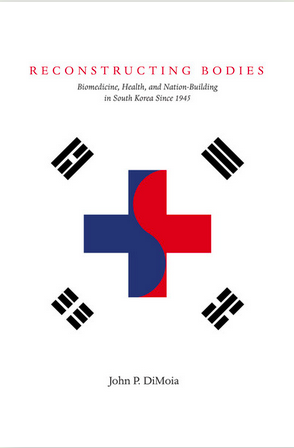DiMoia, J. (2013). Reconstructing Bodies: Biomedicine, health, and nation-building in South Korea since 1945. Stanford, California: Stanford University Press.
John P. DiMoia critically assesses how medicine in Korea has historically navigated the complexities of imperialism and social change. Employing the term fragments to represent the various elements from which medical discourse in South Korea has been assembled from, DiMoia contends that historically occupied South Korea has a bifurcated medical epistemology and ontology. Assembling the book as case studies, DiMoia reveals how the dichotomy of Western and Korean medicine has infiltrated various areas of health and medicine, including public health and epidemics, embodiment, reproductive behaviors, biological sampling and reconstructive surgeries.
Beginning at the point in time of Japanese occupation of Korea (1910-1945), DiMoia explains that the presence of medical pluralism in Korean society–mainly, the dichotomy between Korean traditional medicine (influenced by traditional Chinese medicine) and Western biomedicine (influenced by American and Japanese imperialism) — was cause for a range of confusion. The ambivalence created by this categorical confusion (2), has resulted in the unequal power relationship between Korean traditional medicine and Western biomedicine. For example, DiMoia argues that the reason that traditional Korean medicine was suppressed with the new licensing system was the Japanese colonizers’ eagerness to bring medical modernity to their colony (5). Moreover, upon the end of Japanese occupation, the American Military adopted a deeply ambivalent attitude towards traditional practitioners of Korean medicine (52), consequently replicating many of the choices made under Japanese colonialism (66).
In providing an example of how medical knowledge and information is disseminated and proliferated, DiMoia demonstrates ideas about medicine and health originated from institutions in larger Korean cities, and consequently must travel through a difficult course to reach the outer limits of the country. For example, his framing of the ‘Minnesota Project’: a collaborative relationship between America and Korea that saw American medical technology and methods (i.e. surgery) be implemented in major hospitals in Seoul, the Korean capital. As DiMoia carefully highlights, this new medical technology did not immediately take hold and ‘convince’ citizens of its use, and proliferate throughout Korea; rather, it gradually made its way through public acceptance, beginning in inner cities such as Seoul, and eventually reaching outside to rural areas (albeit much later). Along the way, US medicine was constantly under scrutiny and suspicion, however, it did eventually gain wide acceptance and usage.
DiMoia is able to capture the tension of the challenges that Western Biomedicine has brought to the ‘Korean body’ through exploring medical transitions such as the proliferation of plastic surgeries and reproductive technologies. Akin to the aforementioned dichotomy between biomedicine and Korean medicine, this is another instance of ambivalence that characterizes medical imperialism. For example, DiMoia examines how reconstructive surgeries intersect with Western influence, including the controversy and ambivalence that this brought to the ethics of changing eye-lid size. Furthermore, reproductive technologies brought by imperial powers such as America were experimented on Korean citizens, mainly women, leading to the exploitation of Korean bodies under a colonial regime.
While DiMoia masterfully crafts the Japanese imperial project, there is less here on the significant role played by the US in this regard. For example, DiMoia does make a point to acknowledge that the American military held an ambivalent attitude towards practitioners of Korean medicine. But could perhaps benefit from a more thorough unpacking of the motivations and goals of America proliferating power and knowledge throughout the Korean peninsula.
In spite of this, DiMoia’s book is an important study on how the imperial and colonial power of Japan have intersected with the Korean medical system. It is a clear demonstration of the networks of actors using the less powerful for their own personal and industrial gain. It is an argument against the natural proliferation of Western biomedicine, and an important framework of medical imperialism that has great use for further colonial studies. Furthermore, DiMoia’s contention that the Korean state has performed its own internal colonization, in ‘leaving rural villagers (the “traditional”) behind for a new type of favored citizen: an ideal much cleaner, healthier, and disciplined’ (226) is noteworthy. In sum, Dimoia’s analysis provides important evidence to show that Medical imperialism does not happen along a linear trajectory; rather, it intersects with historical context, cultural ideas about the body, international relations, and forms of identity. Given the pandemic of 2020 and the resulting homogenizing medical approaches, this contribution to understanding medicine as serving imperialism has lasting significance.
Bryce Anderson is a Canadian PhD student based at Dalhousie University. His research focus on suicide, and more broadly health and the history of medicine, with a focus on South Korea.
© 2021 Bryce Anderson
Bryce Anderson is a Canadian PhD student based at Dalhousie University. His research focus on suicide, and more broadly health and the history of medicine, with a focus on South Korea

